NW Greenland Slides Summer Fieldwork 2022
Image Carousel with 32 slides
A carousel is a rotating set of images. Use the previous and next buttons to change the displayed slide
-
Slide 1: Rock samples were collected by helicopter in areas of NW Greenland.
-
Slide 2: PI Jason Briner, Grad students Karlee Prince and Caleb Walcott, Lead PI Joerg Schaefer, and Arctic Field Support
-
Slide 3: Karlee Prince, Graduate Student, collects a rock sample from NW Greenland cosmogenic sampling.
-
Slide 4: The Arctic Fritillary Butterfly is found in many Arctic locations, including around much of Greenland.
-
Slide 5: Arctic Willow plant, Salix Arctica covers sections of ground once scraped by glacial ice.
-
Slide 6: Caleb Walcott, graduate student, confirms the correct labeling of the rock core sections once collected.
-
Slide 7: Clam shells buried in the sediment hint of changes in sea level for this area of NW Greenland.
-
Slide 8: Clusters of large crystals appear in this rock sample that has been shaped and reworked over time.
-
Slide 9: The sedmient deposits contain shells and materials that can be carbon dated to gather age dates.
-
Slide 10: The Shaw drill bits edges must be kept sharp to be able to cut through the rock
-
Slide 11: Dryas Integrifolia is from the rose family and is a common Arctic species.
-
Slide 12: Each core section is carefully labeled by segment depth and location for follow up in the lab,
-
Slide 13: Glacial erratic deposited by the ice sheet is a useful rock for sampling.
-
Slide 14: Glaciers carry large amounts of sediment from under the ice sheet to the ocean.
-
Slide 15: Glaciers are constantly carrying ice from the main ice sheet towards the ocean.
-
Slide 16: Rock core of gneiss drilled from the NW Greenland beckrock.
-
Slide 17: Karlee Prince cuts into the bedrock with a drill to extract a rock sample.
-
Slide 18: Karlee Prince holds a freshly drilled rock core
-
Slide 19: Looking down the core hole
-
Slide 20: Meltwater channels melt and refreeze on the ice sheet
-
Slide 21: Meltwater channel on the ice surface NW Greenland
-
Slide 22: Musk ox skull NW Greenland
-
Slide 23: Musk ox skull rests in an icy stream
-
Slide 24: Papaver Radicatum a species of Arctic poppy dots the landscape
-
Slide 25: Project lead PI Joerg Shaefer dilling rock core sample in NW Greeland
-
Slide 26: Rock sampling at the edge of the glacier
-
Slide 27: Shell deposited in the steep sediment beds of NW Greenland
-
Slide 28: Silene Acaulis is a ‘compass flower’, that is it flowers on the south side of the plant cluster first
-
Slide 29: Small granite chunks can be seen in this rock sample from NW Greenland
-
Slide 30: The ice moves the earth leaving behind steep mounds of sediment on its edges
-
Slide 31: Team tent in the foreground is overshadowed by the ice sheet behind.
-
Slide 32: Waterfall of meltwater streaming off the rocky edge of NW Greenland

Rock samples were collected by helicopter in areas of NW Greenland.

PI Jason Briner, Grad students Karlee Prince and Caleb Walcott, Lead PI Joerg Schaefer, and Arctic Field Support

Karlee Prince, Graduate Student, collects a rock sample from NW Greenland cosmogenic sampling.

The Arctic Fritillary Butterfly is found in many Arctic locations, including around much of Greenland.

Arctic Willow plant, Salix Arctica covers sections of ground once scraped by glacial ice.

Caleb Walcott, graduate student, confirms the correct labeling of the rock core sections once collected.

Clam shells buried in the sediment hint of changes in sea level for this area of NW Greenland.

Clusters of large crystals appear in this rock sample that has been shaped and reworked over time.

The sedmient deposits contain shells and materials that can be carbon dated to gather age dates.

The Shaw drill bits edges must be kept sharp to be able to cut through the rock

Dryas Integrifolia is from the rose family and is a common Arctic species.

Each core section is carefully labeled by segment depth and location for follow up in the lab,

Glacial erratic deposited by the ice sheet is a useful rock for sampling.

Glaciers carry large amounts of sediment from under the ice sheet to the ocean.

Glaciers are constantly carrying ice from the main ice sheet towards the ocean.
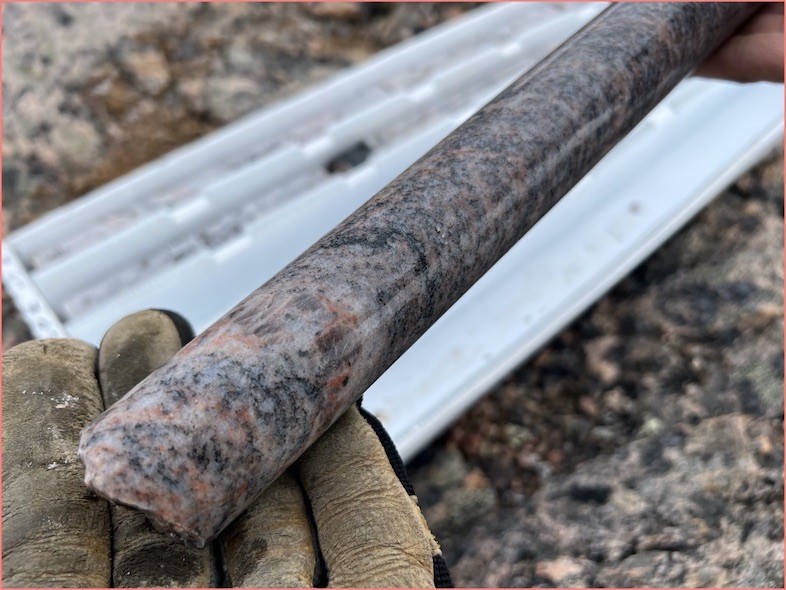
Rock core of gneiss drilled from the NW Greenland beckrock.
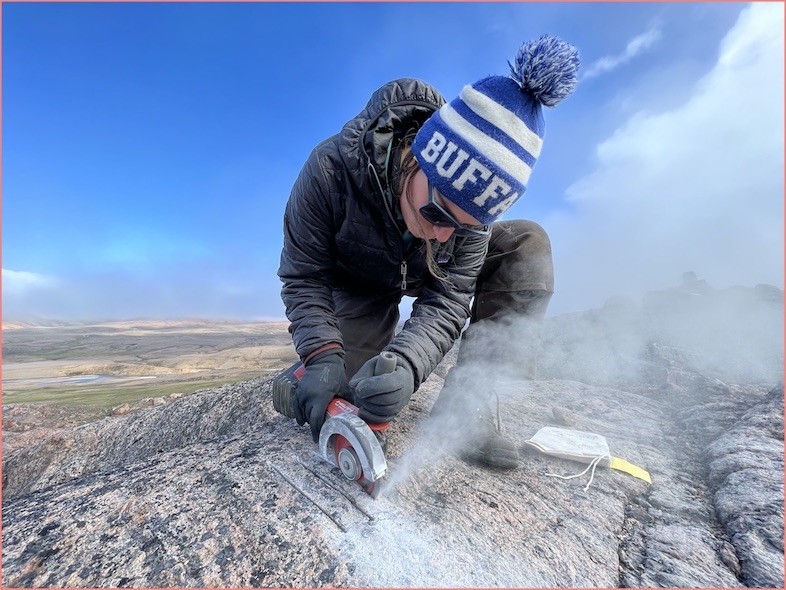
Karlee Prince cuts into the bedrock with a drill to extract a rock sample.

Karlee Prince holds a freshly drilled rock core

Looking down the core hole

Meltwater channels melt and refreeze on the ice sheet
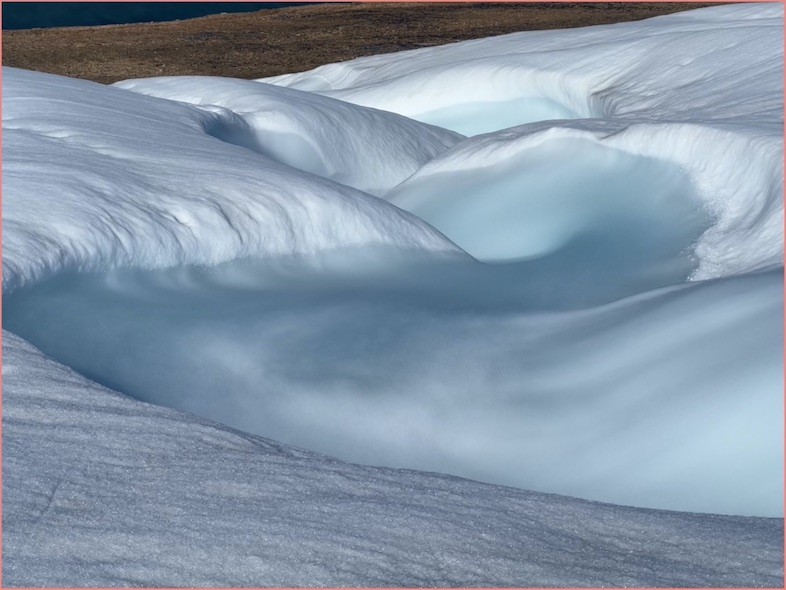
Meltwater channel on the ice surface NW Greenland

Musk ox skull NW Greenland

Musk ox skull rests in an icy stream

Papaver Radicatum a species of Arctic poppy dots the landscape

Project lead PI Joerg Shaefer dilling rock core sample in NW Greeland

Rock sampling at the edge of the glacier

Shell deposited in the steep sediment beds of NW Greenland

Silene Acaulis is a ‘compass flower’, that is it flowers on the south side of the plant cluster first

Small granite chunks can be seen in this rock sample from NW Greenland

The ice moves the earth leaving behind steep mounds of sediment on its edges

Team tent in the foreground is overshadowed by the ice sheet behind.
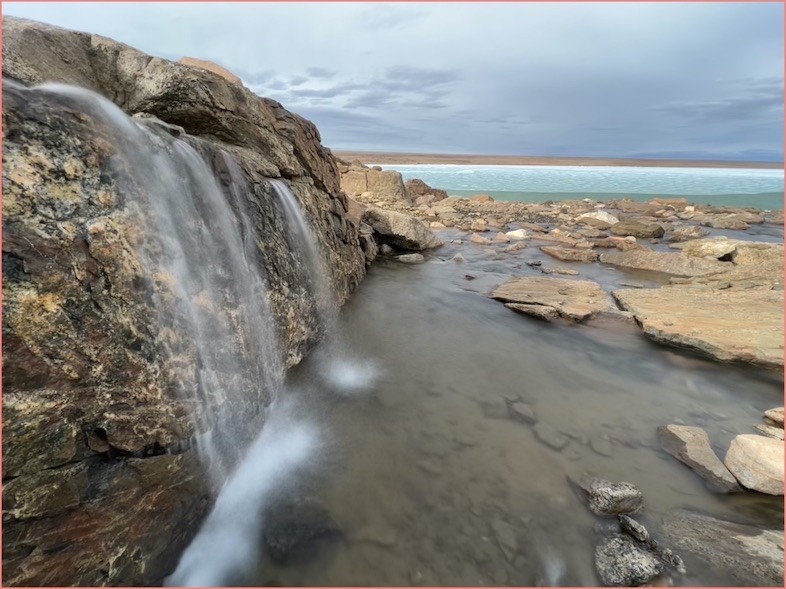
Waterfall of meltwater streaming off the rocky edge of NW Greenland
Site Assessment Survey Spring 2022
Image Carousel with 17 slides
A carousel is a rotating set of images. Use the previous and next buttons to change the displayed slide
-
Slide 1: What looks like 'mountain toes’ border the Greenland coast with ice flowing between the rock sections.
-
Slide 2: The sun hangs low in the sky highlighting the rough surface
-
Slide 3: Setting up the seismics for ice testing
-
Slide 4: Tents are set up with flags marking their location in case of storm.
-
Slide 5: The change in ice surface is reflective of how fast and over what it moves. The flat surface shows floating ice, the wrinkles and ridges show ice that is accelerating compared to the ice around it.
-
Slide 6: A spectacular polar sun dog that appeared on a bright sunny days.
-
Slide 7: Greenland buildings are often painted bright colors - yellows, reds, greens, purples.
-
Slide 8: The days are short in the spring when the field work was underway.
-
Slide 9: Handrills are used to help set the small explosives in the ice.
-
Slide 10: A small, concentrated explosive (PETN) is lowered into the ice, that when triggered, sends sound vibrations down into the ice.
-
Slide 11: Wind and storms that move through the area mound snow and ice over the equipment.
-
Slide 12: Ice is shot into the air as the small explosion is set off.
-
Slide 13: Camp site one from above. Yellow tents appear small on the icesheet but the yellow color helps them stand out.
-
Slide 14: Snowmobiles are the way to move quickly across the ice surface with sledges towed behind.
-
Slide 15: Setting out on snowmobiles to check the area.
-
Slide 16: Jen after travelling by snowmobile. Covering up is important as ice collects on clothes and any exposed surface.
-
Slide 17: The colors of the sun, sky and ice as the sun hangs low in the sky.
What looks like 'mountain toes’ border the Greenland coast with ice flowing between the rock sections.

The sun hangs low in the sky highlighting the rough surface

Setting up the seismics for ice testing

Tents are set up with flags marking their location in case of storm.

The change in ice surface is reflective of how fast and over what it moves. The flat surface shows floating ice, the wrinkles and ridges show ice that is accelerating compared to the ice around it.

A spectacular polar sun dog that appeared on a bright sunny days.

Greenland buildings are often painted bright colors - yellows, reds, greens, purples.

The days are short in the spring when the field work was underway.

Handrills are used to help set the small explosives in the ice.

A small, concentrated explosive (PETN) is lowered into the ice, that when triggered, sends sound vibrations down into the ice.

Wind and storms that move through the area mound snow and ice over the equipment.

Ice is shot into the air as the small explosion is set off.
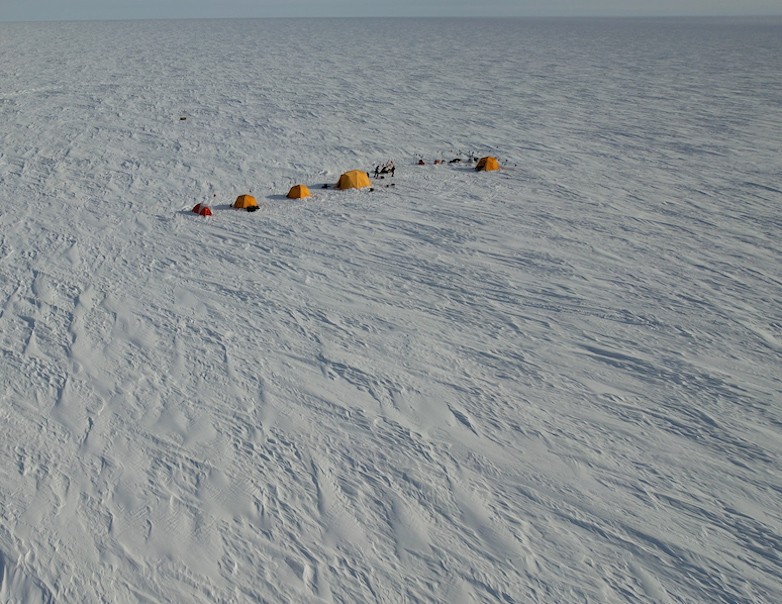
Camp site one from above. Yellow tents appear small on the icesheet but the yellow color helps them stand out.

Snowmobiles are the way to move quickly across the ice surface with sledges towed behind.

Setting out on snowmobiles to check the area.

Jen after travelling by snowmobile. Covering up is important as ice collects on clothes and any exposed surface.

The colors of the sun, sky and ice as the sun hangs low in the sky.

The GreenDrill project is funded under the National Science Foundation Office of Polar Programs.
